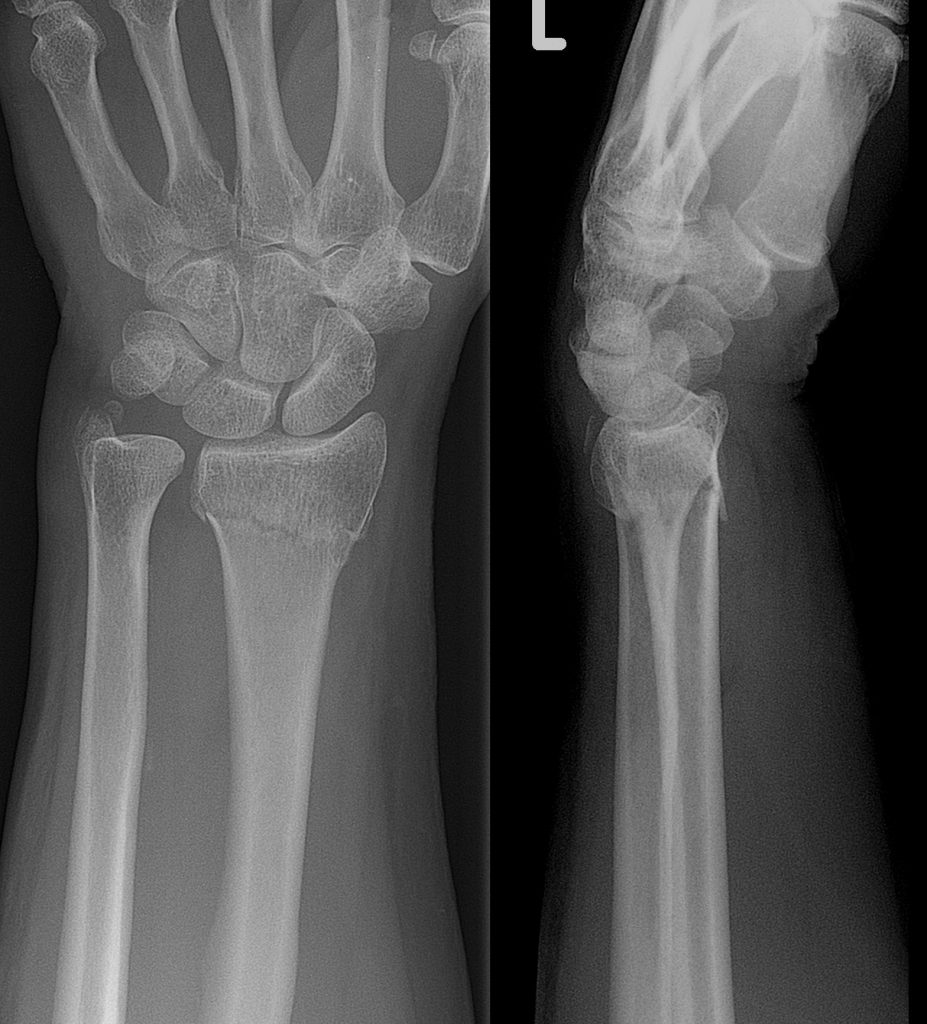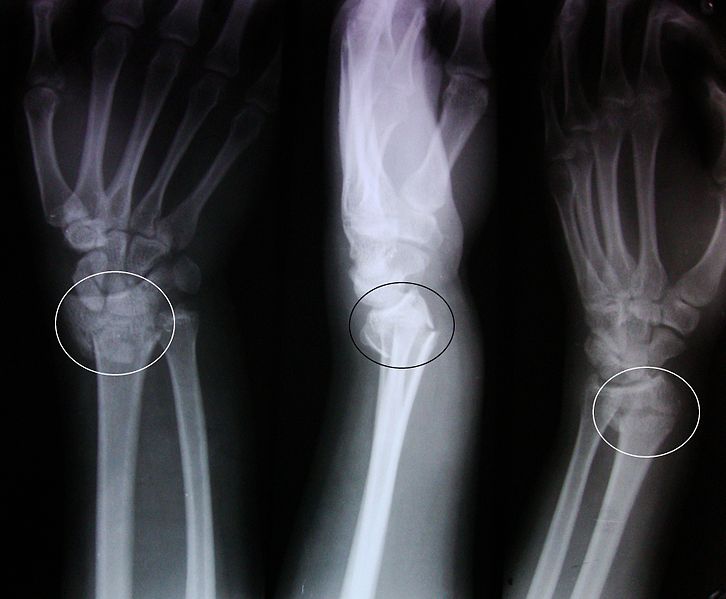
Trauma
This was previously featured in an exam

A 76 year old woman presents to the Emergency Department after falling in a supermarket. She is able to give a clear history of tripping on a "wet floor sign". She is complaining of pain in the left wrist. On examination you note a deformity and x-ray is arranged. What is the diagnosis?
Answer:
Colles' fracture affects the radius within 2.5cm of the wrist, such that the distal fragment is angulated to point dorsally. It usually results from a fall onto an outstretched hand. Osteoporosis contributes to an increased frequency in post- menopausal women. Colles’ fractures produce characteristic clinical deformity (sometimes likened to a ‘dinner fork’).Wrist Injuries
Trauma
Last Updated: 13th February 2021
Colles' fracture
This fracture affects the radius within 2.5cm of the wrist, such that the distal fragment is angulated to point dorsally. It usually results from a fall onto an outstretched hand. Osteoporosis contributes to an increased frequency in post- menopausal women. Colles’ fractures produce characteristic clinical deformity (sometimes likened to a ‘dinner fork’). Check for scaphoid tenderness, distal sensation, and pulses in all cases.
X-rays
X-ray appearances include one of more of the following:
- Posterior and radial displacement (translation) of the distal fragment
- Angulation of the distal fragment to point dorsally (the articular surface of the distal radius normally has a 5° forward tilt on the lateral wrist X- ray)
- Angulation of the distal fragment to point more radially (the articular surface of the distal radius is normally tilted 22° towards the ulnar side on an AP wrist X- ray)
- Impaction, leading to shortening of the radius in relation to the ulnar

Colles' fracture. (Image by Ashish j29, CC BY 3.0 <https://creativecommons.org/licenses/by/3.0>, via Wikimedia Commons)
Management
Provide analgesia; immobilise in a backslab POP, and elevate with a sling. Discharge those with undisplaced fractures (if they will manage at home), and arrange fracture clinic follow- up. Advise the patient to keep moving the fingers, thumb, elbow, and shoulder.
MUA is required for:
- Grossly displaced fractures.
- Loss of normal forward radial articular surface tilt on lateral wrist X- ray. (Neutral or minimal tilt may be acceptable in the very young or very old (particularly in the non- dominant limb). Seek senior advice if unsure.)
Patients with compound fractures and/ or symptoms of nerve compression require urgent MUA. For many other patients, the timing of the procedure is less important. Many EDs undertake closed manipulation of Colles’ fractures in adult patients at the time of initial presentation, whilst others arrange for the patient to return for the procedure within 1– 2 days to a specific theatre list as a day case.
Manipulating Colles' fractures
Discuss the risks and benefits of the procedure. In particular, explain that, if left untreated, an angulated Colles’ fracture may result in long- term stiffness and a significantly weaker grip. The principal risks of manipulation are:
- Tears to the skin on the dorsum of the wrist (especially in those with thin skin, e.g. patients on steroids, and/ or significant swelling, e.g. those on warfarin).
- Late slippage of the bones requiring a further procedure.
- Risks of the anaesthesia employed.
The anaesthetic options available include:
- Haematoma block
- IV regional anaesthesia (Bier's block)
- IV sedation
- GA
The choice of anaesthetic will depend upon local protocols, as well as patient- related factors such as the type of fracture and extent of fasting. Evidence suggests that Bier’s block is superior to haematoma block.
Different individuals may employ different techniques, but the aim is to attempt to return the anatomy to its previous position. In particular, it is important to correct the dorsal angulation (‘restore the volar cortex’). Many descriptions of reduction techniques involve initial traction and ‘disimpaction’ of the fragments, followed by wrist flexion and pronation, with pressure over the distal radial fragment(s). Some operators focus more upon gentle direct manipulation of the distal fragment, rather than indirect measures (traction, wrist flexion, etc.).
Following manipulation, apply a backslab POP, whilst maintaining the reduction, with the wrist slightly flexed and pronated (avoid excessive flexion as this can cause additional long- term problems). Satisfactory reduction can be confirmed by image intensifier/ X- ray. If the reduction is not satisfactory, repeat the manipulation procedure.
Complications
Patients may present to the ED with later complications following Colles’ fracture (and the treatment provided for it), including the following:
- Stiffness of wrist and adjacent limb joints
- Malunion and cosmetic problems
- Reflex sympathetic dystrophy (Sudeck’s atrophy)
- Carpal tunnel syndrome
- Extensor pollicis longus rupture
Smith's fracture
This is an unstable distal radius fracture (sometimes referred to as a ‘reverse Colles’ fracture’) where the distal fragment is impacted, tilted to point anteriorly, and often displaced anteriorly. It usually follows a fall onto a flexed wrist. Give analgesia; immobilise in a volar slab POP, and refer for MUA (often difficult to hold in position after reduction) or open reduction and internal fixation (ORIF) using a buttress plate (preferred in some orthopaedic centres).
Barton’s and reverse Barton's Fracture
An intra-articular fracture involving only the dorsal or volar portion of the distal radius is called a Barton’s fracture and reverse Barton’s fracture, respectively, although describing them as ‘dorsal Barton’s fracture’ and ‘volar Barton’s fracture’ may avoid possible confusion. The resultant dorsal or volar fragment tends to slip, so the fracture is inherently unstable. Provide analgesia; immobilise in a POP backslab, and refer. Most patients require ORIF and plating.
Isolated radial styloid fracture
This is caused by similar mechanisms of injury as scaphoid fractures (i.e. falls onto an outstretched hand or kick- back injuries). It is sometimes referred to as a Hutchinson fracture. Treat with analgesia, backslab POP, and an elevation sling, and refer to the fracture clinic. Internal fixation is occasionally required.
Wrist sprain
- Exclude scaphoid or other fracture (or dislocation) before considering the diagnosis of a ‘simple wrist sprain’ (triquetral avulsions are particularly easy to miss).
- Relatively minor damage to ligaments around the wrist can occur following hyperextension or flexion of the wrist, causing swelling and tenderness around the joint.
- Treat with a wrist splint or Tubigrip® (elasticated tubular) support, analgesia or NSAIDs, and progressive exercise.
- Continuing pain and problems arouse suspicions of more significant injury (possibly involving other structures such as the scapholunate ligament or triangular fibrocartilage complex). Refer for specialist investigation.
Triangular fibrocartilage complex injury
- The triangular fibrocartilage complex (TFCC) at the distal end of the ulna may be injured with associated structures.
- Often, these injuries only become apparent later, when what was diagnosed as a ‘simple wrist sprain’ fails to settle— pain and tenderness persist over the TFCC.
- Arrange specialist follow- up for further investigation (e.g. MRI) and treatment.
Report A Problem
Is there something wrong with this question? Let us know and we’ll fix it as soon as possible.
Loading Form...
- Biochemistry
- Blood Gases
- Haematology
| Biochemistry | Normal Value |
|---|---|
| Sodium | 135 – 145 mmol/l |
| Potassium | 3.0 – 4.5 mmol/l |
| Urea | 2.5 – 7.5 mmol/l |
| Glucose | 3.5 – 5.0 mmol/l |
| Creatinine | 35 – 135 μmol/l |
| Alanine Aminotransferase (ALT) | 5 – 35 U/l |
| Gamma-glutamyl Transferase (GGT) | < 65 U/l |
| Alkaline Phosphatase (ALP) | 30 – 135 U/l |
| Aspartate Aminotransferase (AST) | < 40 U/l |
| Total Protein | 60 – 80 g/l |
| Albumin | 35 – 50 g/l |
| Globulin | 2.4 – 3.5 g/dl |
| Amylase | < 70 U/l |
| Total Bilirubin | 3 – 17 μmol/l |
| Calcium | 2.1 – 2.5 mmol/l |
| Chloride | 95 – 105 mmol/l |
| Phosphate | 0.8 – 1.4 mmol/l |
| Haematology | Normal Value |
|---|---|
| Haemoglobin | 11.5 – 16.6 g/dl |
| White Blood Cells | 4.0 – 11.0 x 109/l |
| Platelets | 150 – 450 x 109/l |
| MCV | 80 – 96 fl |
| MCHC | 32 – 36 g/dl |
| Neutrophils | 2.0 – 7.5 x 109/l |
| Lymphocytes | 1.5 – 4.0 x 109/l |
| Monocytes | 0.3 – 1.0 x 109/l |
| Eosinophils | 0.1 – 0.5 x 109/l |
| Basophils | < 0.2 x 109/l |
| Reticulocytes | < 2% |
| Haematocrit | 0.35 – 0.49 |
| Red Cell Distribution Width | 11 – 15% |
| Blood Gases | Normal Value |
|---|---|
| pH | 7.35 – 7.45 |
| pO2 | 11 – 14 kPa |
| pCO2 | 4.5 – 6.0 kPa |
| Base Excess | -2 – +2 mmol/l |
| Bicarbonate | 24 – 30 mmol/l |
| Lactate | < 2 mmol/l |

